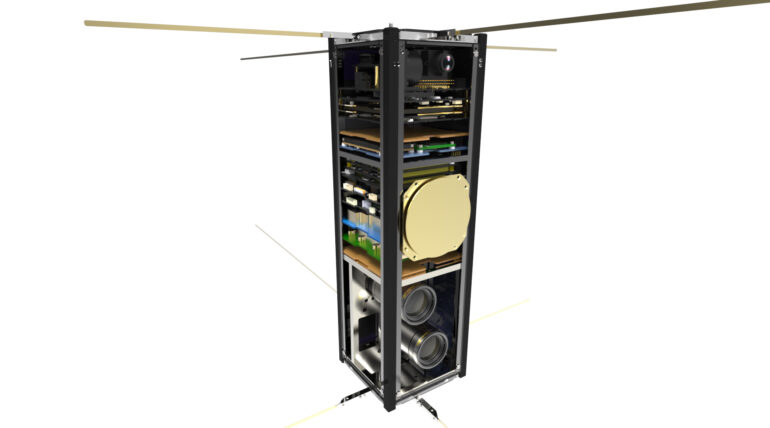
February 28, 2025
Five years into democracy, on 23 February 1999, South Africa launched its first locally developed satellite, positioning the country among global spacefaring nations. But Egypt was the first African nation to successfully launch a satellite named Nilesat 101 into space in April 1998. Following the SunSat-1 launch, South Africa continued to expand its space capabilities.
South Africa’s role and legacy in the global space industry
South Africa is advantageously positioned to provide services such as telemetry, tracking and command (TT&C) from the southern hemisphere. During the 1960s, NASA established a deep space tracking station in Hartebeesthoek which contributed to missions such as the Apollo moon landings. This set the foundation for South Africa’s involvement in space science and satellite technology. The Hartebeesthoek site was handed over to the South African government in 1975 and is now part of the South African National Space Agency (SANSA) established in 2010 through the SANSA Act 36 of 2008.
The country maintains strong collaborations with private and public space agencies worldwide to cement its position as an African partner of choice in space missions. These partnerships enable South African scientists and engineers to contribute to or benefit from global space missions, technology and research initiatives. From the Hartebeesthoek ground station, the country has thus far supported more than 600 global missions and hosts infrastructure for clients spread in the Global North, particularly Europe and America.
Growing the domestic space industry
Through the National Space Strategy South Africa aims to strengthen its local space industry, moving from being primarily an end-user of space technology to a developer of homegrown systems and capabilities. The National Space Strategy outlines a vision for a sustainable and competitive space sector that supports national priorities such as innovation, economic growth and job creation. Central to this effort is the development of local private sector space science and technology industry.
The Department of Science, Technology and Innovation has been at the forefront of the implementation of the space strategy, particularly the establishment of a thriving private space industry. Local private companies such SCS Space, CubeSpace and Pinkmatter and Newspace Systems benefitted from the government partnership to supply critical space instrumentation to global space missions. Government programmes such as New Earth Observation Frontiers (NEOFrontiers), the Small, Medium, and Micro Enterprises Innovation Support Fund Programme, aims to assist start-ups that have space-based ideas.
Ambitions for a thriving African space industry
South Africa aims to play a leading role in fostering space development across the African continent. The National Space Strategy highlights the importance of collaboration with other African nations, particularly in developing shared infrastructure, expertise and technology for space applications. One key initiative is the African Resource and Environmental Management Constellation (ARMC), which involves partnering with African countries to enhance Earth observation capabilities for sustainable resource management. Additionally, South Africa seeks to facilitate technology transfer, capacity building, and training programmes to support emerging space initiatives within the continent. By positioning itself as a regional hub for space science and technology, South Africa contributes to strengthening Africa’s collective space capabilities, ensuring that the continent benefits from the advancements in satellite technology, communication and scientific research.
The African Youth Demographic Dividend
The approval of the Science Engagement Strategy by Cabinet in January 2015 has formalised the era of science and society engaging to enhance and improve lives, with 11 target audiences identified for regular engagement with the National System of Innovation. SANSA has a vibrant space outreach programme that uses the wow factor of outer space to inspire the next generation of space engineers, scientists, researchers, and entrepreneurs who will drive the nation’s contribution to the global space industry beyond the intermediate spacefaring market share.
Space science and technology rejuvenates existing industries and has demonstrated higher return on investment in fast-tracking the migration from largely resource-based economies to circular knowledge economies, with the emergence of the private sector in the new space era of the billionaire entrepreneurs. The wow factor of outer space exploration propels the ambitious National Development Plan target to produce 450 000 science graduates annually leading to the year 2030. Building on the initial gains of the first 30 years of democracy, transformative initiatives like intrapreneurship and entrepreneurship across the space value chain will flip the proverbial script of employment as the popular transition from academia to industry.
The Human Capital Development Pipeline begins with supporting thousands of school learners to pursue STEM careers after graduation with science degrees.
At 13 satellites launched into outer space by the government, universities, and the space sector companies, South Africa is leading Africa as the most industrialised nation with most of the satellite component developed locally.
Approximately 20 space engineering companies are currently exporting $1 billion of space qualified components, subsystems, and fully developed satellite systems to the global market, with the ambitious target of $10 billion by 2030.
These space companies in the upstream space value chain require highly trained professionals beyond the highly theoretical graduates coming out of academic institutions who still need two years of intensive training. With Africa as the most youthful continent, and Youth Communities of Practice being established to represent the voice of young people, platforms like the National Space Conference and the National Earth Observation and Space Secretariat (NEOSS) present networking opportunities between youth and captains of industry aimed at narrowing the supply and demand skills gap and co-developing customised solutions that the space companies can fund as investment in their future staff.


